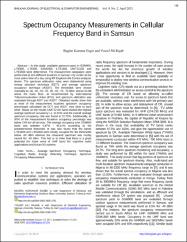Spectrum occupancy measurements in cellular frequency band in Samsun
Citation
ENGİZ B. K,RAJAB Y. A (2021). Spectrum Occupancy Measurements in Cellular Frequency Band in Samsun. Balkan Journal of Electrical and Computer Engineering, 9(2), 138 - 143. Doi: 10.17694/bajece.867294Abstract
In this study, available spectrum parts in GSM900, LTE800, LTE900, GSM1800, LTE1800, UMTS2100 and LTE2600 were determined. The measurement campaigns were performed at 115 different locations in Samsun city center at the most active time of a day using RF Explorer 6G Combo analyzer device. The spectrum utilization rates were determined using energy detection technique (EDT), and average spectrum occupancy technique (ASOT). The thresholds were chosen manually as -40, -45, -50, -55, -60, -65, -70, -75 dBm, and as 10-dB above the noise floor, as recommended by International Telecommunication Union (ITU), and spectrum utilization was evaluated through EDT and ASOT. Obtained results show that at most of the measurement locations spectrum occupancy percentages calculated via EDT and ASOT very close to each other. Based on the results UMTS2100 band showed the highest average spectrum occupancy i.e. 33.91% and the overall average spectrum occupancy rate was found to 22.72%. Additionally, at 50% of the measurement locations occupancy percentage was below 33% for all services. The average occupancy over GSM900 band was between 0.87% - 66.61% according to the predetermined threshold. It was also found that the bands LTE1800 and LTE2600 were mostly occupied for the thresholds below -60 dBm whereas the measured spectrum was mostly vacant for -40 dBm. This led us to infer that there is a great potential for share some of UHF band for cognitive radio applications and future 5G systems.
















